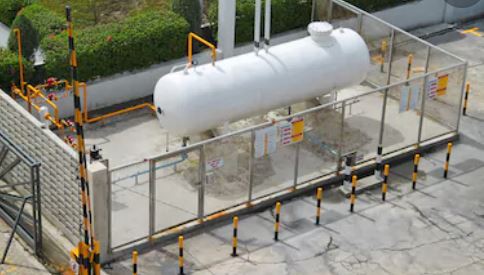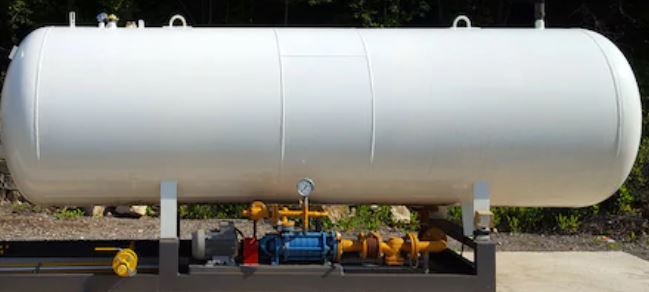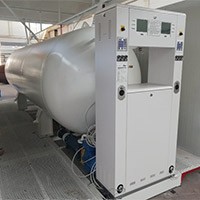

LPG Storage Tank
LPG tanks are manufactured in the status of pressure vessels, up to a maximum of 115 atmospheres gas pressure and resistant to external factors. It preserves LPG gas safely. There are two types of gas tanks, cylinder and toroidal ( Simit). Generally, 3 - 4 mm thick steel sheet is used in this type of tanks. These sheets are combined with x-ray seam welding system . LPG Tanks must meet the ECER 67 standard. LPG tanks cannot be used for more than 10 years. Tanks that have reached the end of their life must be destroyed. The gas tank is made of plastic. The plastic gas tank is very easy to pierce and tear in case of an accident. Therefore, LPG Tank is safer in case of accident.
LPG Tank types:
Storage tank
It is a container closed to the atmosphere, made of steel, in which LPG will be stored.
Small pressure tank
It is a pressure vessel closed to the atmosphere, made of steel with a total water capacity of less than 15 m3.
Big Tank
It is a pressure vessel closed to the atmosphere, made of steel, with a total water capacity of 15.1m3 to 110m3.
Aboveground Tank
They are tanks that are above ground level on all sides and covered with a cover material such as sand and soil. The entire surface of the tanks should be painted with white paint that will reflect sunlight. In addition, the tank area should be suitable for safety distances with appropriate measurement.
Underground Tank
They are tanks whose upper surface of the body is under the ground. The tank cover should remain partially above ground.
Covered tank
These are tanks that are above ground level or partially underground and covered with at least 30 cm of soil, sand, flammable and non- corrosive material on all sides.
STORAGE OF LPG AS BULK
LPG storage tanks;
To the nearest LPG storage tank, buildings or building groups;
To the neighboring plot boundary,
Main traffic roads or railways,
It should be placed in accordance with the minimum safety distances according to the distance of the tanks to each other . LPG storage tanks should never be placed inside buildings, places such as roofs and terraces.
Installation of Aboveground Tank
Aboveground tanks should be fixed by sitting on the carrier concrete base in accordance with the standards from the front or rear two legs.
Ground
Aboveground tanks and evaporators should be grounded. The minimum resistance value of this contact means good grounding. Grounding has 2 purposes.
1- Discharge of static charges accumulated on the surface due to atmospheric conditions to the soil in order not to cause sparks .
2- Prevention of a possible electrical leakage to the body in installations containing electrical devices .
The grounding measurement should be made with the ' meggermeter '. In flange pairs, materials that will provide electrical conductivity (copper-sheet metal) should be used between the two flange surfaces.
Underground Tank Installation
Underground tanks, concrete block on a suitable carrier to standard four standing anchoring it must be fixed by.
Before being mounted in the pit, painting and coating of underground tank maintenance service must be; If there is any damage, assembly should not be done before it is removed.
The top surface of the tank body should be min. 15 cm, max . It should be 30 cm below. In this case, necessary precautions should be taken against the tank being damaged by abrasion, vehicle traffic or other reasons.
Cathodic protection must be applied to protect the underground tank against corrosion .
Mounting the LPG Tank to the vehicle
LPG tank in passenger cars is usually built using a toroidal or cylinder tank at the back of the luggage compartment .
The most important issue in tank assembly; It is to mount the multi valve on the tank. The indicator on the multivalve and the multivalve should be in horizontal position. Tanks; They are conveniently produced in different lengths and diameters. Liter capacities vary according to size. The assembly is the same regardless of the size of the tank.
The duties of the Multi valve on the LPG Tank are as follows;
- Must be connected on LPG Tank .
- It makes gas filling process to the tank.
- Sets the filling limit.
- It shows the fuel level in the tank.
- It directs the LPG to the engine.
- It controls the excess flow with the overflow valve.
- If, for any reason, the pipes leading to the engine are punctured, it cuts off the gas outlet and provides safety.
Maximum capacity of close to 80% of the total capacity of the reservoir ' id . The remaining 20% like section is filled with LPG vapors. Thus, with an increase in temperature, the liquid inside is allowed to expand without filling the entire volume . The multivalve keeps the gas filling at a safe level.
When the necessary assembly is made with the right product selection in the converted vehicles, there is no performance loss or damage. But the selected product quality must also be high. It will be beneficial for you to choose products that provide one hundred percent customer satisfaction. In addition , thanks to the use of autogas , much less carbon waste is left compared to gasoline. In this way, it also provides protection of engine and engine oil.
Compared to most hydrocarbon fuels, the carbon-hydrogen ratio of LPG is lower. Therefore, much less carbon dioxide (CO2) is released per unit energy it produces.
- LPG is a mixture of butane and propane gases in different proportions . Although it varies according to the mixture ratio, it produces more energy per kilogram than all other hydrocarbon fuels (natural gas, gasoline, diesel, etc.). It has a high calorific value.
- According to the United Nations International Panel on Climate Change (IPCC), the global warming potential (GWP) factor of carbon dioxide (CO2), namely the greenhouse gas effect, is 1, whereas that of natural gas (methane) is 25 and LPG is 0.
- The most important pollutants in terms of air pollution and human health are solid particles (PM) and nitrogen oxides ( NOx ). It is calculated that health expenditures arising from PM in European Union countries are 75.000 Euro per ton and that arising from NOx is 12.000 Euro.
- Solid particles, air pollution is estimated to reduce the life of every person in the European Union countries for an average of 8 to 6 months. In addition, it is determined that respiratory problems caused by open fevers cost the lives of 1.5 million people annually in the world.
- Emission of solid particles (PM) of LPG is 25-35 times less than wood and coal, 10 times less than diesel and 30 percent less than gasoline.
- automotive fuel between nitrogen oxides ( NOx ) emissions at low LPG fuel is LPG . A LPG vehicle produces 50 percent less NOx per kilometer than a natural gas vehicle, 75 percent less than a gasoline vehicle, and 200 percent less than a diesel vehicle .
- Considering the health expenditures caused by harmful substances released per 1000 kilometers in the European Union, LPG autogas provides 70% less health expenditure than gasoline and 700% less than diesel.



